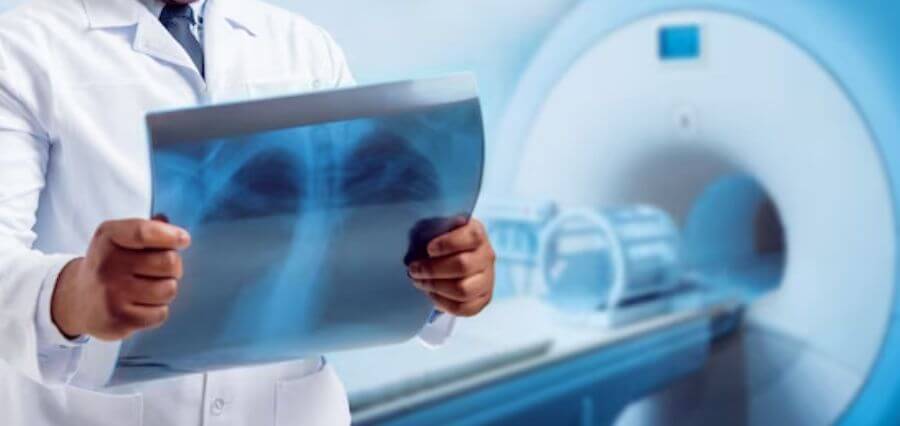From X-rays to AI
The journey of medical imaging solutions from their inception to the present day is a remarkable testament to human ingenuity and technological progress. The evolution of these solutions, starting with the discovery of X-rays, has not only transformed the field of medicine but has also revolutionized how diseases are diagnosed and treated. From the rudimentary beginnings of X-rays to the era of artificial intelligence (AI), medical imaging has come a long way, reshaping healthcare practices and patient outcomes.
Let’s dive in to understand the revolutionizing healthcare diagnosis and treatment!
X-rays
The year 1895 marked a pivotal moment in medical history with Wilhelm Conrad Roentgen’s discovery of X-rays. This breakthrough enabled the visualization of internal structures within the human body without invasive procedures. The ability to see bones, foreign objects, and even certain soft tissues was a revolutionary leap forward. However, the early X-ray technology had limitations regarding image quality and potential radiation risks, which paved the way for refinements and further innovations.
Radiography and Fluoroscopy
The early 20th century witnessed the refinement of X-ray technology, leading to the development of radiography and fluoroscopy. Radiography, or the capturing of static images, became a cornerstone for diagnosing fractures, assessing lung conditions, and identifying foreign bodies. Conversely, fluoroscopy allowed real-time visualization of moving structures, enabling procedures such as barium studies and angiography. These innovations transformed medical practice by offering non-invasive insights into the body’s internal dynamics.
Computed Tomography (CT)
The 1970s saw the advent of computed tomography (CT), a groundbreaking development that introduced cross-sectional imaging. CT scans revolutionized medical imaging by generating detailed three-dimensional images that unveiled previously hidden anatomical structures. This capability was precious for diagnosing complex conditions like tumors, internal bleeding, and neurological disorders. CT scans provided unprecedented clarity and were pivotal in guiding surgical interventions.
Magnetic Resonance Imaging (MRI)
In the 1980s, magnetic resonance imaging (MRI) emerged as a transformative addition to the medical imaging toolkit. Unlike X-rays or CT scans, MRI harnesses strong magnetic fields and radio waves to create detailed images of soft tissues, such as the brain, muscles, and organs. MRI’s ability to differentiate between various soft tissues with remarkable clarity opened up new avenues for diagnosing previously challenging conditions. This technology proved indispensable in neurology, oncology, and musculoskeletal imaging.
Ultrasound
Ultrasound imaging, or sonography, introduced a non-invasive and radiation-free method for visualizing internal structures. By radiating high-frequency sound waves that bounce off tissues and organs, ultrasound devices create real-time images that aid in assessing pregnancies, diagnosing abdominal issues, and guiding procedures like biopsies. The portability and real-time imaging capabilities of ultrasound have made it an essential tool in various medical settings, from clinics to emergency rooms.
Nuclear Medicine and Positron Emission Tomography (PET)
Advancements in medical imaging were not limited to anatomical visualization; functional insights also became crucial. Nuclear medicine techniques, such as single-photon emission computed tomography (SPECT) and positron emission tomography (PET), utilized radioactive tracers to monitor metabolic and physiological processes. PET scans, in particular, enabled the visualization of disease activity at a molecular level, providing critical information for cancer staging, brain studies, and cardiovascular assessments.
Artificial Intelligence (AI) in Medical Imaging
AI algorithms powered by machine learning have demonstrated remarkable capabilities in analyzing medical images, identifying patterns, and assisting radiologists in making accurate diagnoses. These algorithms can sift through vast datasets to identify subtle anomalies that might elude human eyes. AI’s role extends beyond diagnostics; it aids in treatment planning, predicting disease progression, and enhancing image quality.
Telemedicine and Remote Imaging
In recent years, the evolution of medical imaging solutions has extended beyond the confines of hospital walls, thanks to the rise of telemedicine and remote imaging. Emergence of high-speed internet and advanced communication technologies, healthcare providers can now collaborate and consult on medical images from remote locations. This is particularly vital for reaching patients in underserved or rural areas, enabling them to receive expert diagnosis and guidance without extensive travel. Telemedicine has not only improved patient access to care but has also enhanced healthcare efficiency on a global scale.
A Continuous Journey of Innovation
The evolution of medical imaging solutions has been a story of constant innovation, where each milestone has propelled healthcare forward. From the early discovery of X-rays to the complex capabilities of AI, medical imaging has transformed from a static representation of anatomy to a dynamic tool for understanding structure and function. These advancements have improved diagnostic accuracy and contributed to minimally invasive interventions and personalized treatment plans. As technology evolves, the future promises even more exciting possibilities, as medical imaging remains at the forefront of healthcare’s ongoing transformation.















